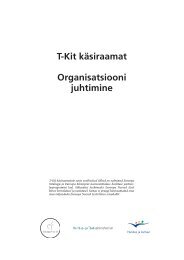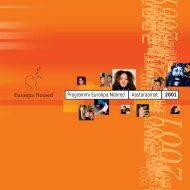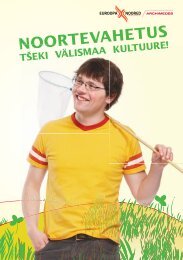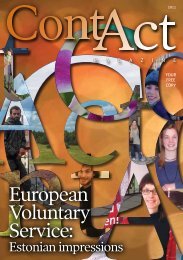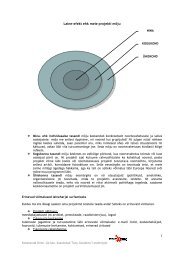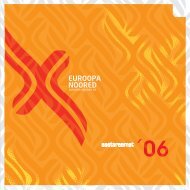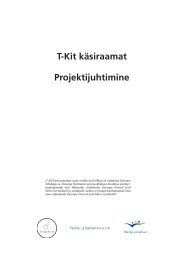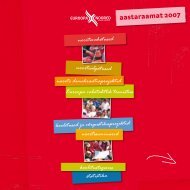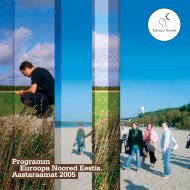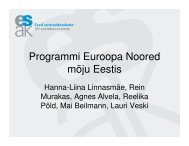Youthpass for better quality in youth exchanges - Euroopa Noored
Youthpass for better quality in youth exchanges - Euroopa Noored
Youthpass for better quality in youth exchanges - Euroopa Noored
Create successful ePaper yourself
Turn your PDF publications into a flip-book with our unique Google optimized e-Paper software.
OUTCOMESof the tra<strong>in</strong><strong>in</strong>g course<strong>Youthpass</strong> <strong>for</strong> <strong>better</strong> <strong>quality</strong> <strong>in</strong> <strong>youth</strong> <strong>exchanges</strong>Haapsalu, Estonia, 25 – 30 June 2009Foreword<strong>Youthpass</strong> - it is not just acertificate. <strong>Youthpass</strong> is ap h i l o s o p h y – a t o o l f o rrecognition of non-<strong>for</strong>maleducation. Together stronglybelieves <strong>in</strong> the value of non<strong>for</strong>maleducation and thebenefits it br<strong>in</strong>gs to youngpeople. That is why we decidedto organise the tra<strong>in</strong><strong>in</strong>g course“<strong>Youthpass</strong> <strong>for</strong> <strong>better</strong> <strong>quality</strong> <strong>in</strong><strong>youth</strong> <strong>exchanges</strong>” and share ourexperience and knowledge withother <strong>youth</strong> organisations fromdifferent countries.We believe it is our smallcontribution to the recognition ofnon-<strong>for</strong>mal education and thatthe participants of the tra<strong>in</strong><strong>in</strong>gcourse will become“ambassadors” of this message<strong>in</strong> their local communities.This newsletter is also part of thedissem<strong>in</strong>ation of results of thetra<strong>in</strong><strong>in</strong>g course. It was preparedtogether by the participants ofthe tra<strong>in</strong><strong>in</strong>g course, with alimited assistance of the tra<strong>in</strong>ers.You can f<strong>in</strong>d <strong>in</strong>side <strong>in</strong><strong>for</strong>mationabout the tra<strong>in</strong><strong>in</strong>g course, about<strong>Youthpass</strong> and several methods<strong>for</strong> self-evaluation as well asother useful h<strong>in</strong>ts.Anna RoganovaProject co-ord<strong>in</strong>atorTogether Estonia
About the tra<strong>in</strong><strong>in</strong>g courseThe idea of the tra<strong>in</strong><strong>in</strong>g course“<strong>Youthpass</strong> <strong>for</strong> <strong>better</strong> <strong>quality</strong> <strong>in</strong><strong>youth</strong> <strong>exchanges</strong>” came from theconclusion that there is a greatneed and demand to develop themethodology and tools of theways of implementation of<strong>Youthpass</strong> <strong>in</strong> the “Youth <strong>in</strong>Action” programme.<strong>Youthpass</strong> became obligatorys<strong>in</strong>ce more than one year now;however, there is a risk that thefantastic recognition tool thathelps also to add greaterimportance to the non-<strong>for</strong>mallearn<strong>in</strong>g process dur<strong>in</strong>g theprojects <strong>in</strong> general, and <strong>youth</strong><strong>exchanges</strong> <strong>in</strong> particular, is notcompletely understood by manyorganisations that areimplement<strong>in</strong>g it.With the support of the resourcecentre SALTO Germany weproposed to set up a tra<strong>in</strong><strong>in</strong>gdedicated to organisations,deal<strong>in</strong>g with <strong>youth</strong> <strong>exchanges</strong>and that need to <strong>in</strong>crease theirknowledge on <strong>Youthpass</strong>:evaluate the exist<strong>in</strong>g experienceand ga<strong>in</strong> concrete tools <strong>in</strong> orderto put it <strong>in</strong>to practice dur<strong>in</strong>gtheir activities and to implementit not just as a diploma, but as am o t i v a t i n g s e l f - a c c e s s e drecognition tool.The tra<strong>in</strong><strong>in</strong>g was led byexperienced <strong>Youthpass</strong> tra<strong>in</strong>ersfrom “Together” organisationnetwork, participat<strong>in</strong>g <strong>in</strong><strong>Youthpass</strong> implementation s<strong>in</strong>ceits pilot experimental phase <strong>in</strong>2006, and cont<strong>in</strong>u<strong>in</strong>g to useYo u t h p a s s d u r i n g t h e i ractivities.What is <strong>Youthpass</strong> ?<strong>Youthpass</strong> is a part of the European Commission’s strategy to foster the recognition of non-<strong>for</strong>mallearn<strong>in</strong>g. As a tool to visualise and to validate learn<strong>in</strong>g outcomes ga<strong>in</strong>ed <strong>in</strong> “Youth <strong>in</strong> Action”projects, it puts policy <strong>in</strong>to practice and practice <strong>in</strong>to policy:
What is <strong>Youthpass</strong>• Creat<strong>in</strong>g their <strong>Youthpass</strong> Certificate together with a support person, participants of “Youth <strong>in</strong>Action” projects have the possibility to describe what they have done <strong>in</strong> their project and whichcompetences they have acquired. Thus, <strong>Youthpass</strong> supports the reflection upon the personalnon-<strong>for</strong>mal learn<strong>in</strong>g process.• Document<strong>in</strong>g the added value of a “Youth <strong>in</strong> Action” project, <strong>Youthpass</strong> visualises and supportsactive European citizenship of young people and <strong>youth</strong> workers.• Be<strong>in</strong>g a Europe-wide validation <strong>in</strong>strument <strong>for</strong> non-<strong>for</strong>mal learn<strong>in</strong>g <strong>in</strong> the <strong>youth</strong> field, <strong>Youthpass</strong>contributes to strengthen<strong>in</strong>g the social recognition of <strong>youth</strong> work.• Mak<strong>in</strong>g visible and validat<strong>in</strong>g key competences through a certificate, <strong>Youthpass</strong> f<strong>in</strong>ally aims atsupport<strong>in</strong>g the employability of young people and <strong>youth</strong> workers.(Source: <strong>youth</strong>pass.eu)Formal/non-<strong>for</strong>mal/<strong>in</strong><strong>for</strong>mal??? What is it???• In<strong>for</strong>mal learn<strong>in</strong>g happens nearly all the time <strong>in</strong> daily life (at home, on the street, <strong>in</strong> cafés, etc) but itis not a planned activity;• Non-<strong>for</strong>mal learn<strong>in</strong>g is voluntary, is assisted by others and is planned;• Formal learn<strong>in</strong>g is structured, regulated from the outsider and <strong>in</strong>volves some <strong>for</strong>m of certification(Source: YouthPass Guide)
Self-Evaluation MethodsSelf-evaluation is an important part of personallearn<strong>in</strong>g process and key role <strong>in</strong> the personaldevelopment. The methods that are used <strong>in</strong> thisprocess are usually practised <strong>in</strong> a group of people(rather smaller groups, which make the participantsmore open). This can make these activities moresocial and <strong>in</strong>teractive.Here you can f<strong>in</strong>d several methods of <strong>in</strong>teractive selfevaluationthat could be also used <strong>in</strong> <strong>Youthpass</strong>implementation:Picture SeaThere are different images of people andobjects cut from the magaz<strong>in</strong>es (postcardsor other) on the table (or on the floor) andevery participant can select the one thathe/she f<strong>in</strong>ds the best <strong>in</strong> describ<strong>in</strong>g him orherself dur<strong>in</strong>g the learn<strong>in</strong>g process. Thisgame gives a chance to reflect his or herway of learn<strong>in</strong>g <strong>in</strong> an <strong>in</strong>teractive way.Magical MirrorIn this activity, you’d need a mirror as a symbol(you can make it from the paper) and a paperposter with questions. These questions can bedivided <strong>in</strong>to three groups: 1. Three characterfeatures that best characterise the person; 2. Threecompetences that the participant wants to learn; 3.Three competences that the participants needs <strong>for</strong>his/her job or other activities. The questions shouldbe reflected <strong>in</strong>dividually and then shared withsomeone else <strong>in</strong> order to get <strong>in</strong> the evaluationprocess. This activity can help with def<strong>in</strong><strong>in</strong>g theirpotential with<strong>in</strong> reflect<strong>in</strong>g over these questions.„It was the easiest way how to share myexperience with other people.“Toufik from France
Self Evaluation FormsFrom the SALTO website (www.salto-<strong>youth</strong>.net/toolbox/), you may download various ready-to use selfevaluation<strong>for</strong>ms or cards. These tolls conta<strong>in</strong> tables,where the participant can write his own evaluation anddef<strong>in</strong>e his/her strategic learn<strong>in</strong>g objectives and ways howto achieve them. This is more <strong>for</strong>mal way, but still cansuit to the needs of some of the participants (that shouldfirst of all def<strong>in</strong>e what type of learner they are).How is my Learn<strong>in</strong>g Flower Do<strong>in</strong>g ?A method <strong>for</strong> reflect<strong>in</strong>g on one’s learn<strong>in</strong>g processThe aim of this exercise is to visualise one’s learn<strong>in</strong>g targets, his/her learn<strong>in</strong>g process and also thef<strong>in</strong>al results.The exercise is based on the parallel between learn<strong>in</strong>g and grow<strong>in</strong>g a plant.The key words <strong>for</strong> display<strong>in</strong>g and deal<strong>in</strong>g with different aspects of the learn<strong>in</strong>g process are:a seed –a field –one’s talent, a plan, a wish, an idea, an ability, a skill, a learn<strong>in</strong>g objective, or whateveris supposed to be developed, to be grownE.g.: If one wants to be confident at speak<strong>in</strong>g a <strong>for</strong>eign language, this is his seed whichneeds to be cared of and grown.one’s surround<strong>in</strong>g, background, learn<strong>in</strong>g conditions: anyth<strong>in</strong>g that is around us and<strong>in</strong>fluences our learn<strong>in</strong>g environment – from an actual room we are learn<strong>in</strong>g <strong>in</strong>, to acurrent social or political situation.E.g.: Someone needs to learn <strong>in</strong> an absolute silence, whereas someone else cannotconcentrate without a TV or radio on.From a different po<strong>in</strong>t of view the field is also our potential, which we have to discoverand further develop – it’s certa<strong>in</strong> that everyone is talented <strong>in</strong> a certa<strong>in</strong> field and it isimportant <strong>for</strong> them to “plant on the fruitful soil”.E.g.: If someone is talented at sports, there is no need <strong>for</strong> him to “grow the seeds ofscience”, but he should use and develop his sport<strong>in</strong>g potential.
tools - every seed needs to be watered and carefully taken care of <strong>in</strong> order to grow and f<strong>in</strong>allygive tasteful fruit. The same is with the learn<strong>in</strong>g objectives: if they receive enough ef<strong>for</strong>tsand a proper field, the will grow <strong>in</strong>to a powerful competence.E.g.: There are several learn<strong>in</strong>g types of people and one should be able to identify his mostefficient learn<strong>in</strong>g style.fruits – after the whole process of learn<strong>in</strong>g the results f<strong>in</strong>ally come or maybe not. There is alwaysa good, patient and hard work<strong>in</strong>g gardener beh<strong>in</strong>d a juicy piece of fruit, on the other side,without any care, trees get dry and br<strong>in</strong>g no results.How’s my learn<strong>in</strong>g flower do<strong>in</strong>g?? That is the crucial question we always ask dur<strong>in</strong>g this exercise.Situation of our flower helps us reflect on the process and partial results of our learn<strong>in</strong>g. Other questionsclosely relate to the situation of the flower:Does it have deep and stable roots?Does it actually grow or fade?Am I satisfied with plant<strong>in</strong>g my flower? Did I choose theright one?What am I go<strong>in</strong>g to do with the fruit? Is it worth pursu<strong>in</strong>gthe grow<strong>in</strong>g process?We can easily f<strong>in</strong>d another type of questions related more closely to our concrete flower us<strong>in</strong>g the keywords mentioned above:Do I have any seed I want to grow? Which one is the right one? ( The 8 key competences should helpus here. )What type of field did I choose? Are there any obstaclesthat need to be taken off the way of grow<strong>in</strong>g?Am I us<strong>in</strong>g appropriate tools to grow what I reallywant? And f<strong>in</strong>ally, how does the fruit look now? How is itgo<strong>in</strong>g to prosper <strong>in</strong> a week/month…
The best way to implement this exercise is by draw<strong>in</strong>g a flower as a visual aid to be able to express andshare our learn<strong>in</strong>g process and also see its development <strong>in</strong> time.Other approach gives us the possibility to look around us on real flowers and types of plants <strong>in</strong> thenature. Not every tree gives tasty fruits, also not every plant has a colourful blossoms.Each day we can go through the key words <strong>for</strong> our flower and, look<strong>in</strong>g at the picture, reflect on how theflower has developed s<strong>in</strong>ce yesterday. Are there any changes? What are feel<strong>in</strong>gs about out learn<strong>in</strong>gprocess? How’s my learn<strong>in</strong>g flower do<strong>in</strong>g?Regardless the flower you are go<strong>in</strong>g to grow, remember and wish this quote was truthful <strong>for</strong> you!„There can be no other occupation like garden<strong>in</strong>g <strong>in</strong> which, if you were to creep up beh<strong>in</strong>dsomeone at their work, you would f<strong>in</strong>d them smil<strong>in</strong>g.“ ~Mirabel OslerHow can we promote the <strong>Youthpass</strong> ??Participants of the tra<strong>in</strong><strong>in</strong>g course got the chance toreceive theoretical and practical knowledge, skillsand competences necessary to promote <strong>Youthpass</strong>and use it <strong>in</strong> their organisations. We all undertaketo become k<strong>in</strong>d of “<strong>Youthpass</strong> Ambassadors” andshare the philosophy further. Dur<strong>in</strong>g one of thetra<strong>in</strong><strong>in</strong>g sessions, each of the participants prepareda specific action plan to use, promote and valoriseYouthPass.Here you can see a few examples of ideas andproposals:“In Italy, I will organise an <strong>in</strong>fo sem<strong>in</strong>ar <strong>in</strong> myorganisation, to write an article or radio <strong>in</strong>terviewabout this tra<strong>in</strong><strong>in</strong>g course to expla<strong>in</strong> what <strong>Youthpass</strong>is.” – Eliana, Italy“I see my role as a <strong>Youthpass</strong> promoter by organis<strong>in</strong>g a<strong>youth</strong> exchange and expla<strong>in</strong><strong>in</strong>g the learn<strong>in</strong>g process <strong>in</strong>non-<strong>for</strong>mal education to the participants.” – Mar<strong>in</strong>e,France“It would be good to do an <strong>in</strong>fo day <strong>for</strong> students and<strong>for</strong> career councillors, also <strong>for</strong> personal managers of companies.” - Mari – Liis, Estonia
Programme of the tra<strong>in</strong><strong>in</strong>g course25.6. 26.6. 27.6. 28.6. 29.6.8-8:459:0010:30breakfast breakfast breakfast breakfastyou told“competences” ?global politicalconceptaction plan - br<strong>in</strong>g<strong>in</strong>geveryth<strong>in</strong>g togetherwork<strong>in</strong>g onpersonal YParrivals coffee break coffee break coffee break coffee break11:00learn<strong>in</strong>g as suchand learn<strong>in</strong>g <strong>in</strong> YEhow to use <strong>in</strong>question<strong>in</strong>g the<strong>quality</strong>presentation of theresultsevaluation13:30lunch lunch lunch lunch lunch15:00gett<strong>in</strong>g toknow eachotherexchange ofmethodswhat does it meanpractise? methods,concrete stepsfuture projectsnetwork<strong>in</strong>g nationalvs. <strong>in</strong>ternationallevels16:30coffee break coffee break coffee break coffee break17:00<strong>in</strong>troduction to<strong>Youthpass</strong> andall aroundpresentation ofpersonalexperiences -examples of goodpracticeYP reflection groupYP reflection groupdepartures19:3021:00<strong>in</strong>tercultural d<strong>in</strong>ner d<strong>in</strong>ner d<strong>in</strong>nerd<strong>in</strong>ner cultural even<strong>in</strong>g cultural even<strong>in</strong>g farewell partyL<strong>in</strong>kshttp://www.<strong>youth</strong>pass.eu – The official <strong>Youthpass</strong> web sitehttp://demo.<strong>youth</strong>pass.eu – Demo-version of the system <strong>for</strong> generat<strong>in</strong>g <strong>Youthpass</strong>eshttp://ec.europa.eu/<strong>youth</strong>/<strong>youth</strong>-<strong>in</strong>-action-programme/ - The official web site of the Youth <strong>in</strong> Actionprogrammehttp://www.network-together.eu – Website of Together NetworkThe “<strong>Youthpass</strong> <strong>for</strong> <strong>better</strong> <strong>quality</strong> <strong>in</strong> <strong>youth</strong> <strong>exchanges</strong>” was f<strong>in</strong>anced by the Youth <strong>in</strong> Action programme ofthe European Commission and organised by Together Estonia <strong>in</strong> June 2009.Tra<strong>in</strong>ers team:Anna Roganova, anna.roganova@network-together.euJiri Peterka, jiri.peterka@network-together.eu



